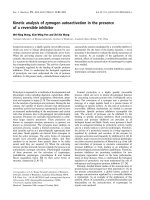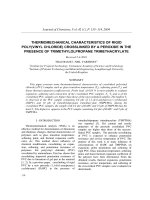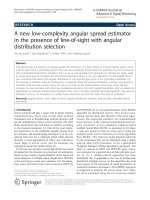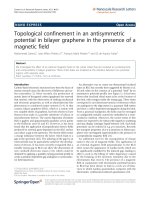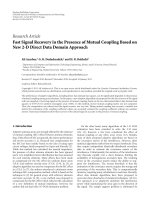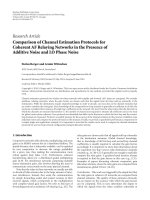New record for a Dinoflagellate species (Citharistes regius stein) in the northern levantine basin (eastern Mediterranean)
Bạn đang xem bản rút gọn của tài liệu. Xem và tải ngay bản đầy đủ của tài liệu tại đây (99.5 KB, 3 trang )
Turk J Bot
28 (2004) 507-509
â TĩBTAK
Research Note
New Record for a Dinoflagellate Species (Citharistes regius Stein) in
the Northern Levantine Basin (Eastern Mediterranean)
Sevim POLAT
ầukurova University, Faculty of Fisheries, 01330, Balcal, Adana - TURKEY
Received: 30.10.2003
Accepted: 08.03.2004
Abstract: The presence of a dinoflagellate species, Citharistes regius Stein belonging to genus Citharistes Stein, is reported for the
first time from the eastern Mediterranean coast of Turkey. This species is also a first report for all Turkish seas and the Levantine
Basin. Morphological characteristics of this species are described in detail and information about its ecological distribution is given.
Key Words: Citharistes regius, dinoflagellate, phytoplankton, Levantine Basin, eastern Mediterranean.
Kuzey Levantin Baseninde (DoÔu Akdeniz) Bir Dinoflagellat Tỹrỹ
(Citharistes regius Stein) ỗin Yeni Kayt
ệzet: Dinoflagellatlardan Citharistes Stein cinsine ait Citharistes regius Stein tỹrỹ Tỹrkiyenin doÔu Akdeniz kysal sularnda ilk kez
rapor edilmifltir. Bu tỹr ayn zamanda tỹm Tỹrkiye denizleri ve Levantin Baseni iỗin ilk kayttr. Bu ỗalflmada, C. regius tỹrỹnỹn
morfolojik ửzellikleri ayrntl olarak aỗklanmfl ve ekolojik daÔlm ile ilgili bilgiler verilmifltir.
Anahtar Sửzcỹkler: Citharistes regius, dinoflagellat, fitoplankton, Levantin Baseni, doÔu Akdeniz.
Introduction
The dinoflagellates are important members of the
marine phytoplankton. They are predominantly
unicellular, eukaryotic, flagellated organisms including
photosynthetic and non-photosynthetic members (Taylor,
1987). The number of living species of dinoflagellates is
estimated to be about 2000, and more than 50% of the
thecate dinoflagellates of the world oceans are
represented in the Mediterranean Sea (Kimor, 1983).
The Levantine Sea is a sub-basin located in the southeastern corner of the Mediterranean Sea. This area is
described as the most oligotrophic part of the
Mediterranean Sea. This oligotrophy results in low
species diversity compared to that of the western
Mediterranean. The high temperatures prevailing in the
eastern Mediterranean, especially compared to its
western basin, give this region a tropical character with
regard to planktonic biota (Kimor, 1983). The
dinoflagellates in the Mediterranean consist of
cosmopolitan eurythermal species, together with tropical-
subtropical species and a small group of autochthonous
Mediterranean forms (Halim, 1990). The migration of
Red Sea and even Indopacific species into the
Mediterranean Sea through the Suez Canal contributes to
the increased plankton diversity in the eastern
Mediterranean. In addition, marine vessels play an
important role in the transportation of phytoplankton
from one site to another.
A dinoflagellate species, Citharistes regius Stein, is
reported for the first time from the eastern
Mediterranean coast of Turkey. Information about its
morphology and ecology is provided.
Materials and Methods
Phytoplankton identification was performed from the
net samples taken from skenderun Bay (lat. 36 41' N
36 44' N and long. 35 52' E 35 49' E), on the
eastern Mediterranean coast of Turkey (Figure 1).
Sampling was conducted in late winter 2001. Samples
507
New Record for a Dinoflagellate Species (Citharistes regius Stein) in the Northern Levantine Basin (Eastern Mediterranean)
38 °N
T U R K E Y
‹skenderun
Sampling Bay
area
37 °N
36 °N
35 °N
EASTERN MEDITERRANEAN SEA
26 °E
28 °N
30 °N
32 °N
34 °N
36 °N
Figure 1. The location of the sampling area.
were taken from surface water using a standard plankton
net with a 55 µm mesh size. The samples were preserved
in 4% formaldehyde solution. Surface water
temperatures were between 16.5 and 17.5 °C and
salinity was between 37 and 38‰ during the sampling
time. An Olympus BX-50 phase-contrast microscope was
used in the identification of the species and
photomicrography. For identification and taxonomy
Wood (1968), Taylor (1976), Rampi & Bernhard (1980),
Balech (1988), Tomas (1997) and Fensome et al. (1993)
were used as references.
Results and Discussion
The dinoflagellate species Citharistes regius is very
rare and only a few specimens have been found. The
taxonomy of this species is as follows:
Division: Dinoflagellata
Subdivision: Dinokaryota
Class: Dinophyceae
Subclass: Dinophysiphycidae
Order: Dinophysiales
Family: Dinophysiaceae
Genus: Citharistes Stein 1883
Citharistes is a unique genus consisting of two species.
The cell body is C-shaped with the dorsally excavated
hypotheca forming a phaeosome (symbiont) chamber. Its
posterior margin is semicircular and its girdle is strongly
anterior. The anterior girdle list is wide and flaring
508
whereas the posterior girdle list is narrow (Wood, 1968).
The species of this genera are heterotrophic and they do
not have chloroplasts. They form symbiotic associations
with cyanobacteria (Gordon et al., 1994).
Citharistes regius Stein
This is a rare species. It has a C-shaped body in right
lateral view ranging from small to medium size. Cell
surface is areolate with pores. The left sulcal list extends
with ribs from the posterior girdle area to the vicinity of
the posterior of the cell. This species is distinguished from
Citharistes apsteinii Schütt in that its phaeosome chamber
is smaller. C. regius is an oceanic species and is distributed
in tropical, subtropical and temperate seas (Wood, 1968;
Tomas, 1997). Cells are 38-40 µm long and 22-25 µm
wide (Figure 2 a,b).
C. regius has been reported from the south-west
Atlantic and western Mediterranean (Rampi & Bernhard
1980; Balech, 1988). This species has not been recorded
in Turkish seas (Koray et al., 1999; Koray, 2001) or the
Levantine Sea (Gomez, 2003) before.
One weak possibility is that it was not encountered in
the previous studies. It is also possible that it has recently
been transported into the eastern Mediterranean through
the Suez Canal or via ballast waters. Subtropical
characteristics of the eastern Mediterranean such as high
temperatures and salinity may favour the acclimatisation
of tropical species. In addition, the progressive warming
of the Mediterranean Sea might have caused a change in
biodiversity and an increase in warm-water species
S. POLAT
anterior girdle
list
posterior girdle
list
phaeosome
chamber
left sulcal
list
hypotheca
a
b
Figure 2. a) Light microscopy photograph of Citharistes regius, b) Cell structure details (original) (Scale 10 µm).
(Gomez&Claustre, 2003). The investigation of
phytoplankton communities of the eastern Mediterranean
is receiving greater attention as regards observing the
variation of biodiversity in this changing environment.
Acknowledgements
The author would like to thank Prof. Dr. Tufan Koray
for his valuable advice during the preparation of the
manuscript.
References
Balech E (1988). Los Dinoflagellados del Atlantico Sudoccidental,
Madrid: Publicaciones Especiales Instituto Espanol de
Oceanografia, 1: 310.
Fensome RA, Taylor FJR, Norris G, Sarjeant WAS, Wharton DI, Williams
GL (1993). A Classification of Living and Fossil Dinoflagellates.
Hanover: Sheridan Press, p. 351.
Gomez F, Claustre H (2003). The genus Asterodinium (Dinophyceae) as
a possible biological indicator of warming in the western
Mediterranean, J Mar Biol Ass UK 83: 173-174.
Gomez F (2003). Checklist of Mediterranean
Dinoflagellates, Bot Mar 46: 215-242.
Kimor B (1983). Distinctive features of the phytoplankton of the
eastern Mediterranean Ann Inst Oceanogr Paris 59: 97-106.
Koray T, Gökp›nar fi, Yurga L, Türko¤lu M, Polat S (1999).
Microplankton Species of Turkish Seas,
Koray T (2001). Türkiye Denizleri Fitoplankton Türleri Kontrol Listesi.
EÜ Su Ürünleri Dergisi 18: 1-23.
Rampi L & Bernhard M (1980). Chiave per la Determinazione delle
Peridinee Pelagiche Mediterranee, CNEN-RT/BIO (80)8.
Free-Living
Taylor FJR (1976). Dinoflagellates from the International Indian Ocean
Expedition, Bibliotheca Botanica, 132: 234.
Gordon N, Angel DL, Neori A, Kress N, Kimor B (1994). Heterotrophic
dinoflagellates with symbiotic cyanobacteria and nitrogen
limitation in the Gulf of Aqaba. Mar Ecol Prog Ser 107: 83-88.
Taylor FJR (1987). The Biology of Dinoflagellates. Botanical
Monographs, Oxford: Blackwell Scientific Publications.
Halim Y (1990). On the potential migration of Indo-Pacific plankton
through the Suez Canal. Bulletin de l’Institute Oceanographique
Monaco, 7: 11-27.
Tomas CR (1997). Identifying Marine Phytoplankton. New York:
Academic Press, p. 858.
Wood EJF (1968). Dinoflagellates of the Caribbean Sea and Adjacent
Areas, Florida: Univ. Miami Press.
509

